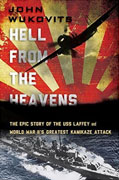Hell from the Heavens
John Wukovits
book reviews:
· general fiction
· chick lit/romance
· sci-fi/fantasy
· graphic novels
· nonfiction
· audio books
· author interviews
· children's books @
curledupkids.com
· DVD reviews @
curledupdvd.com
newsletter
win books
buy online
links
home
for authors
& publishers
for reviewers

 |
Hell from the Heavens: The Epic Story of the USS Laffey and World War II's Greatest Kamikaze Attack John Wukovits Da Capo Press Hardcover 336 pages April 2015 |
|
World War II brought untold misery to millions of people. It also had--and continues to have--a significant impact on world affairs. As such, it is not surprising that there are now many tales of the heroism displayed by soldiers of various nations in battle and frequently in the face of great odds. The book under review here tells one such tale of great courage: specifically, the story of the USS Laffey, a destroyer that was manufactured in Bath, Maine, and commissioned in Boston on February 8, 1944.
Under Becton’s able leadership, the Laffey first saw noteworthy action off the shores of Normandy as a part of the D-Day landings. The tasks assigned to Laffey and to other destroyers were to “screen the battleships and cruisers as they bombarded German gun positions ashore, engage the German navy should it approach the landing area, and use their guns as artillery to destroy German pillboxes, casemated guns, and mobile artillery until the Army could land their own artillery units” (p. 30). Upon the successful completion of these tasks, the Laffey was ordered to join the American war effort against the Japanese in the Pacific. It is important to comprehend that the action that the Laffey saw off the Normandy shores prepared the crew for all that was in store for it off the coast of Okinawa. In the author’s words, “[a]n inexperienced crew benefited from Normandy. It learned the ropes” (p. 57). In the Pacific, the Laffey participated initially in the landings at Lingayen Gulf in the Philippines and at Iwo Jima and then was significantly involved in the naval invasion of Okinawa. A key threat in this invasion was from Japanese kamikaze aircraft. The kamikaze unit was created by Vice Admiral Takajiro Onishi to “counter American moves in the Philippines. [This unit] would eventually grow into a force that would spread fear throughout the Pacific in late 1944 and into 1945...” (p. 67). One way to fight the obvious danger posed by the kamikaze aircraft was to provide advance warning of their arrival to other ships in a flotilla. To this end, ships were routinely assigned to picket duty—typically far out in the ocean—to provide the requisite advance warning. The Laffey was ordered to duty at Picket Station No. 1, the “most exposed spot of the sixteen picket stations that ringed Okinawa” (p. 134). On April 16, 1945, the Japanese launched a massive kamikaze attack on the Laffey, and the meat of this book delineates the manner in which Becton and his courageous crew resisted this sustained attack. Things initially went well for the Laffey. Of the 22 kamikaze aircraft that attacked the ship, the Laffey’s gunners neutralized the first eight. However, after that, the story changed dramatically. Several kamikaze planes either smashed into the Laffey or lobbed bombs that resulted in the painful death of several crewmen and significant structural damage to the ship. The indomitability of the Laffey personnel in the face of stark odds was perhaps epitomized most by Commander Becton, who proclaimed that he would never abandon his ship as long as even a single gun would fire. The only blemish that this book suffers from is that of repetition. On occasion, the author lets his zeal get the better of him, and he ends up making the same point several times. For instance, the point that 22 kamikaze aircraft attacked the Laffey is made once on p. 148 and then four times again on pp. 150-151. Even so, this is an excellent tome that provides a lucid account of “what a group of individuals can do when united by sound leadership and a deep sense of duty” (p. 232). Originally published on Curled Up With A Good Book at www.curledup.com. © Amitrajeet A. Batabyal, 2015 |
|
|
|
 Click here to learn more about this month's sponsor! |
|
| fiction · sf/f · comic books · nonfiction · audio newsletter · free book contest · buy books online review index · links · · authors & publishers reviewers |
|
| site by ELBO Computing Resources, Inc. | |
 Julian Becton was the commander of the
Laffey. Becton already had substantial combat experience when he took over the
Laffey and its crew in early 1944. He was calm but direct when he needed to be, respectful of all his crew members, and clearly displayed leadership qualities in abundance. As a result, his crew respected him greatly. For instance, the author points out that the
Laffey’s Quartermaster Phoutrides respected Becton almost as much as his own father—a man who the Quartermaster respected more than any other human being.
Julian Becton was the commander of the
Laffey. Becton already had substantial combat experience when he took over the
Laffey and its crew in early 1944. He was calm but direct when he needed to be, respectful of all his crew members, and clearly displayed leadership qualities in abundance. As a result, his crew respected him greatly. For instance, the author points out that the
Laffey’s Quartermaster Phoutrides respected Becton almost as much as his own father—a man who the Quartermaster respected more than any other human being.